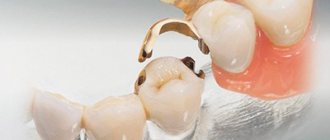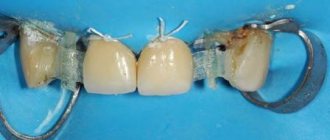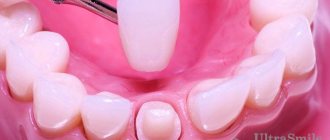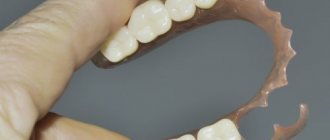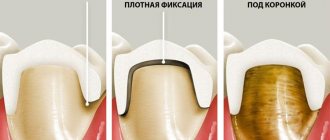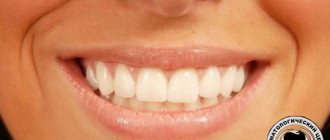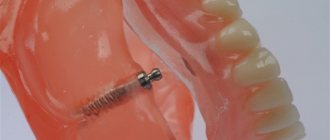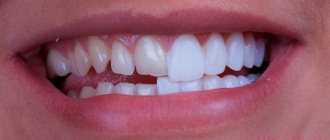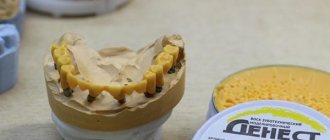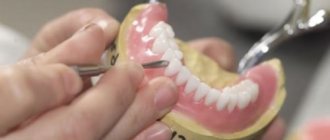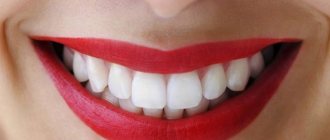How many unpleasant sensations deformed, chipped or missing teeth give a person, and all because they interfere with the ability to make a favorable impression and deprive them of confidence in further communication. To correct this and restore the former beauty of your smile, you need to seek help from a dentist. Unfortunately, it is not always easy for the patient to explain his wishes in words. And this is where wax modeling comes to the rescue!
Modeling allows you to achieve a perfect match between the dentures and the teeth. With the help of modeling, it is possible to reproduce as accurately as possible the anatomical shape and functioning features of the dentition, as well as to ensure a high degree of aesthetics of the oral cavity.
Teeth modeling methods
- indirect (wax-up) - diagnostic wax modeling; - direct (mock-up) - trying on a prototype of teeth (translated from English as “life-size model”).
Indirect modeling steps
First, the dentist takes impressions of the upper and lower jaws.
In this case, silicone is used, since it is very important that the material is of high quality. Then the doctor records the habitual closure of the jaws, preparing the bite ridges, and performs registration using a face bow. The next stage is work in the articulator. This is the name of a special device that allows you to simulate the movement of the lower jaw and debug all chewing movements of the dental apparatus. If the bite decreases, then with the help of special studies, taking into account facial characteristics, they calculate how many millimeters it needs to be raised.
A silicone model of teeth is placed on a plaster base in an articulator and analyzed. At the same time, the dental technician takes into account the functional and aesthetic wishes of the patient and the dentist. He then makes a wax model and shows it to the patient. If necessary, correction is made.
If the patient is satisfied with everything, then a permanent prosthesis is made in the laboratory based on the Wax-up model.
How does forward modeling work?
Mock-up modeling is performed directly in the oral cavity.
It allows you to determine the optimal shape of the prosthesis. Direct modeling can be figuratively compared to trying on a dress. The doctor makes silicone impressions of the teeth. Great importance should be paid to modeling the palatal surface, without which it will not be possible to make a full-fledged cast.
Composite plastic is placed into the silicone impression (it is better to use a material that is different in color from the teeth) and placed on the patient’s teeth. The impression is then removed and excess materials are removed from it. If necessary, increase the size of the teeth and reduce the width of the spaces between them.
Next, the dentist, using special brushes and prophylactic paste, cleans the teeth of plaque. At the same time, no manipulations are performed with the teeth: they are not prepared or sawed, as with conventional prosthetics, which allows maintaining the integrity of the dental apparatus.
The base shade of enamel and layer-by-layer dentine are applied to the template. Next, the doctor restores the structure of the tooth, forming anatomical details on the surface of the model, including mamelons (the so-called protrusions and tubercles on the teeth). Restoration of the dental structure is carried out sequentially, starting from the oral surface and gradually moving to the vestibular surface. Finally, an enamel shade application is made.
Mechanical finishing is carried out after the surface of the model has dried. If the model is even a little wet, it will be difficult to visually control the quality of grinding. Polish the surface carefully using special silicone heads of different shapes. In this case, their rotation frequency should be low.
The teeth are treated with a special fixing glue and the prepared model is attached to them.
The patient can walk around with temporary teeth, which will allow him to observe his sensations and determine what exactly needs to be corrected. The doctor will also have the opportunity to study the reaction of the mandibular joint.
The technician can produce several models so that the client can make the best choice.
If the patient no longer has any complaints, then the resulting model is sent to the laboratory, where permanent dentures are made based on it.
It is especially recommended to use Mock-up models for patients who need to improve their bite, as well as for those whose teeth are severely worn out. The models are also irreplaceable when performing prosthetics on implants.
DENTAL WAXES for SIMULATION OF MODERN DENTURE CONSTRUCTIONSI.Ya.Poyurovskaya, T.F.Sutugina (Central Research Institute of Dentistry of the Ministry of Health of the Russian Federation, Laboratory of Dental Materials)
Waxes are one of the oldest materials used in dentistry. For example, beeswax began to be used for taking impressions more than 200 years ago. Nowadays waxes are used in dentistry in many cases. They are used as a temporary material from which models of inlays, crowns, pins, partial and complete dentures are created. At the stages of making wax models of future dentures, special wax compositions of auxiliary value are used; in the literature they are called auxiliary or technological waxes. Dental waxes are classified according to their purpose, distinguishing between modeling, technological auxiliary and impression waxes. Based on the main purpose, modeling waxes include not only waxes for modeling inlays, crowns, fixed bridges, etc., but also base waxes. However, the latter are classified as a separate class of auxiliary materials, because The technology for replacing temporary wax material with a permanent acrylic base differs significantly from the technology in the manufacture of fixed denture structures, especially modern technologies for casting metal alloys using lost wax models. Thus, modeling waxes usually include wax for inlays (inlays/onlays - inlay/onlay), veneers, veneers, casting and clasp wax (wax for modeling clasp or arched prostheses) and modeling waxes intended for modeling various types of fixed bridges , including solid metal, metal-ceramic and metal-plastic, as well as some others. Inlay wax is used to make a temporary or wax-up model of an inlay, crown, or post tooth, which is then used to create a mold used in lost-wax denture casting technology. Type I inlay wax is hard and is used to make inlays using the direct method. Type II wax is soft and is used to make wax inlays using the indirect or indirect method on models. In addition, inlay waxes are sometimes used to model attachments in combined dentures. Casting waxes are used to model the thin parts of partial dentures and the junction of crowns and pontics in bridges. They are especially suitable for the production of caps and clasps, in which it is necessary to recreate uniform thin elements. It is clear that the quality and, above all, the accuracy of future dentures depends on the quality of the wax model. Therefore, the properties of wax modeling materials are so important, which should ensure the accuracy of the model, prevent dimensional changes and shape distortions during the process of making the model, carrying out fittings and making a mold based on the wax model. The main properties of modeling waxes that ensure the necessary accuracy of models include:
- nlow shrinkage when cooling the wax (<0.1 - 0.15% volume/1°C in the range from 90 to 0°C);
- good plasticity in the temperature range 41-55°C;
- sufficient hardness at a temperature of 37-40°C, ensuring preservation of the model’s shape in the oral cavity;
- absence of stickiness and delamination during processing;
- absence of noticeable ash content, in other words, elimination of the formation of plaque or soot on the walls of the mold after burning out the wax model;
- homogeneity during softening, no delamination;
- exclusion of painting the plaster model;
- the wax layer must adhere to the model and adhere to the previously applied layer of material;
- Modeling waxes should be painted in bright, contrasting colors to facilitate the modeling process.
The main of the listed requirements are included in the “Technical Requirements” section of the draft national standard GOST R for dental modeling wax, corresponding to international standard No. 1561 “Dental casting Wax”.
The properties of waxes, ensuring their ability to model, good plasticity and sufficient hardness in certain temperature ranges, are established in the standards in the form of norms for fluidity indicators (see Table 1), and the ash content of these waxes, according to the requirements of the standards, should not exceed 0.1% . Depending on the specific purpose, the composition of dental wax, or rather the wax composition, changes. But regardless of this, the basis of modeling materials are waxes - organic polymers consisting of hydrocarbons and their derivatives (for example, ethers and alcohols). The average molecular weight of waxes ranges from 400 to 4000, which is significantly lower than the molecular weight of acrylic polymers. Dental waxes are mixtures of natural (for example, paraffin, beeswax, carnauba, spermaceti, ceresin) and synthetic waxes, as well as natural polymers (for example, dammar resin), with the addition of oils and fats (for example, stearic acid), gum (gum arabic) ) and dyes. Natural waxes can be of mineral (petroleum products), plant or animal origin. Paraffin is a relatively soft wax with a low melting point (50° to 70°C). This mineral wax is obtained from refined crude oil and is used in inlay wax compositions and for modeling dental bridges. During processing, paraffin delaminates and does not give a smooth shiny surface; the addition of dammar resin to paraffin eliminates its delamination and cracking, increases density, elasticity and gives the composition a smooth shiny surface. Beeswax is fragile and melts in the temperature range from 60° to 70°C. This wax is obtained from the waste products of bees - honeycombs; it is added to the compositions of many waxes, to which it gives the necessary fluidity at oral temperature. To reduce fluidity and make the surface shiny, carnauba wax is introduced in an optimal amount, but its excess can lead to coagulation - the loss of flakes when the mixture melts. Carnauba wax is a wax of plant origin, which is extracted from carnauba palm trees; it has high hardness and rigidity. Carnauba wax melts at higher temperatures (from 65° to 90°C). It is added to paraffin to increase its hardness and melting point. In modern dental waxes, carnauba wax is partially replaced by synthetic waxes. Synthetic waxes have a certain melting point and are mixed with natural waxes. An example of a synthetic wax is low molecular weight polyethylene. The properties of natural waxes largely depend on the source of their production; this is taken into account by developers and manufacturers of dental wax compositions. In contrast, synthetic waxes are more uniform in composition. Microcrystalline waxes melt at higher temperatures (65° to 90°C) and are added to control the temperature ranges in which wax compositions soften and melt. With their help, they reduce the stress that occurs in the wax during cooling. Microcrystalline waxes are obtained from petroleum. Coloring waxes with various fat dyes (red, blue, green, yellow, pink) facilitates modeling on a white background of the model and often determines the purpose of the wax. The properties of dental waxes depend not only on the composition, but also on the manufacturing technology. With imperfect technology or its violation, waxes with tension and great relaxation are obtained. The creation of waxes with stable properties (in terms of plasticity, melting point, fluidity, etc.) is significantly difficult due to the fact that the components - natural waxes do not have a strictly constant qualitative and quantitative composition. This leads to the fact that the fusion of waxes in certain proportions often does not ensure reproducibility of the properties of the composition. The use of synthetic waxes with stable characteristics as components allows us to solve this problem to some extent. An interesting and relatively recent innovation is the creation of modeling materials that do not contain waxes. They are often called modeling plastics. Modeling materials made from light-curing polymers (for example, Triad VLC, Palavit GLC) can be used to make models of cast metal prostheses, ceramic structures and high-precision attachments. These materials are produced in the form of pastes or liquids of high and low viscosity; the basis of their composition is a diurethane methacrylate oligomer, into which from 40% to 55% of a polymer filler is introduced. Polymer modeling materials are characterized by higher strength and stability due to low fluidity compared to traditional waxes, good dimensional accuracy and the ability to burn out without residue. A comparison of the marginal fit of crowns made using models from modeling plastic and inlay wax showed their identical quality. The model is made from a polymer modeling material by successively applying layers of 3-5 mm, which are cured in a light chamber or using a manual light-curing apparatus. The polymer is completely burned out of the mold before casting by holding the mold at a temperature of 690°C for 45 minutes. The composition of waxes can include both crystalline and amorphous components, each of which is characterized by its own mass-molecular distribution. Therefore, waxes melt over a very wide temperature range, and not at one specific temperature. Waxes have the highest coefficient of thermal expansion of any other material. A high coefficient of thermal expansion is one of the disadvantages of these modeling materials, due to the very polymeric nature of the wax. As a result, significant dimensional changes in castings and poor fixation of cast prostheses could occur if technology for compensating for dimensional changes by expanding the molding materials, as well as other methods, such as the use of compensation varnishes, was not used. The total shrinkage of wax when it is cooled from the melting point, when the wax is in a liquid state, to room temperature, at which the wax becomes solid, can reach such a significant value as 0.4%, which includes shrinkage during solidification and shrinkage caused by cooling to room temperature of already hardened wax. The fluidity of wax in the solid state determines its ability to deform under the influence of weak forces (see table 1). This property is otherwise called creep. As temperature increases and force increases, fluidity increases. At temperatures close to the softening point, the wax can flow under its own weight. In the liquid molten state, the fluidity of wax is characterized by the viscosity index, and in the solid state it is a measure of plastic deformation over a certain period of time. Type I inlay wax requires fluidity to accurately reproduce the topography of the prepared tooth cavity. However, when cooled to room temperature, the fluidity of the wax insert should be minimal to minimize distortion of the resulting model. Partially, waxes exhibit elastic properties and the ability to return to their original shape after removing the deforming load. A straight strip of wax, bent like a clamp, can spontaneously straighten slowly at room temperature. Distortion can occur due to residual stresses resulting from uneven heating of the wax. There are four ways to minimize distortion in wax models. The first is that wax for direct modeling technology, for example, inlays, must be pre-heated evenly at a temperature of 50°C for 15 minutes. Second, the wax model should be quickly filled with molding material. Rigid walls of the mold made of hardened molding material compress the sample and reduce the degree of distortion that may occur in it due to the action of restorative and residual stresses. In addition, if it is not possible to fill the wax model with molding material immediately after production, it should be stored at a reduced temperature. This is because elastic recovery slows down at low temperatures. But you should remember - if the wax model was stored in the refrigerator, it must be kept before pouring the molding material so that it warms up to room temperature. And lastly, it is important that after burning out the wax model, when the lost-wax casting technology is used, there are no residual modeling material or ash in the mold. This residue will interfere with obtaining a quality casting with perfect, fully reproduced edges. That is why standards for modeling materials include a standard for ash content. It is now believed that the technician's work with wax materials in open flame modeling requires a great deal of experience and intuition to produce high quality models. If the technician does not have such experience, then there is a danger of overheating of the modeling wax, destruction of a number of essential components of the wax composition, and shrinkage during cooling may increase significantly. In this regard, it is of interest to use electric spatulas for the production of wax models, which allow maintaining precise temperature parameters for each type of modeling wax. Some companies that produce electric spatulas supply them with a set of modeling tools, and sometimes with waxes specifically designed for working with an electric spatula. Modeling waxes are produced by manufacturers in a wide variety of forms, in the form of blocks or in bulk, but also in the form of blanks of various shapes, including anatomical ones. Casting waxes can be marketed in the form of sheets, rods, wax wire for the gating system, or in bulk. Blanks are also produced in the form of certain elements of fixed dentures, elements of partial removable and clasp dentures (see Table 2). LITERATURE
1. V. N. Trezubov, M. Z. Shteyngart, L. M. Mishnev. Orthopedic dentistry. Applied materials science. 1999, St. Petersburg, publishing house “Special Literature”, p. 192-207 2. E. N. Zhulev Materials science in orthopedic dentistry. 1997, N. Novgorod, p. 26 3. WJO'Brien Dental Materials and Their Selection, publishing house Quintessence books, 3rd edition, 2002, pp. 267-270 4. Dentist's Desk Reference: Materials, Instruments and Equipment, ADA, pp. 192-198 5. Materials science in dentistry. Edited by A.I. Rybakov, M., “Medicine”, 1984, p. 240 6. Catalogs of modeling wax manufacturers.
(No. 6 (41) 2003) pp. 10-13
Benefits of dental modeling
Dental prosthetics using modeling has many advantages:
- • provides the patient with a visual model of the final result;
- • eliminates any defects at the initial stages;
- • relieves discomfort in the future;
- • reduces the duration of addiction;
- • does not damage nearby teeth;
- • eliminates misunderstandings that may arise between the patient and the doctor regarding the shape and other features of the teeth;
- • allows you to take into account all the client’s wishes;
- • provides the opportunity to adjust the model.
Models will help improve the effectiveness of dental restoration only if done well. Our clinic employs highly qualified dentists and uses modern equipment, which guarantees high quality service. We will help you fully restore the functionality and aesthetics of your teeth.
